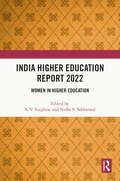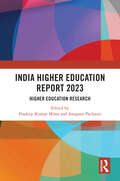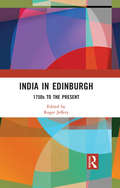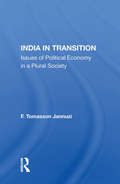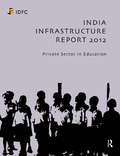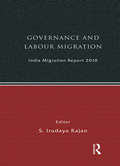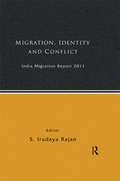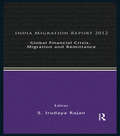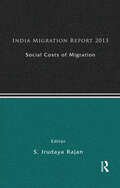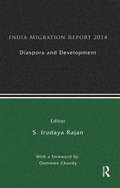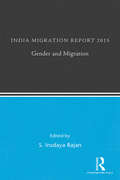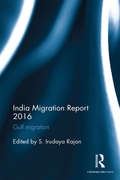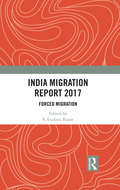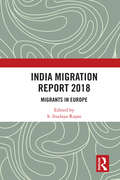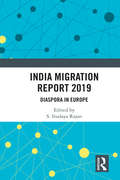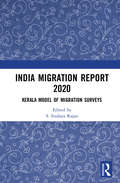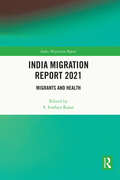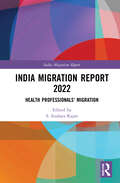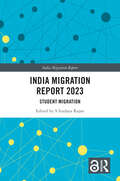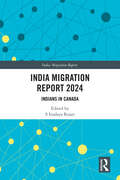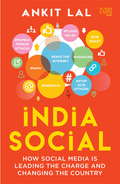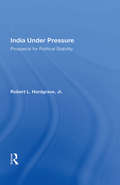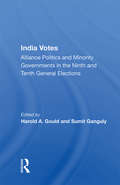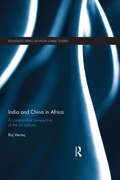- Table View
- List View
India Higher Education Report 2022: Women in Higher Education
by N. V. Varghese Nidhi S. SabharwalThis book studies the various dimensions of gender inequality that persist in higher education and employment in India. It presents an in-depth analysis of the complex challenges women face in higher education participation and translating higher education opportunities into labour market success and to leadership positions, including in academia. It argues that despite a substantial progress towards gender equality in enrolment, these inequalities pose as barriers in realising the transformative role that higher education can have for women’s wellbeing and for the nation’s development. The volume looks at the issues that keep women from accessing the areas of their choice, and the challenges they face in leadership positions in higher education. An important critique of higher education policy and planning, the volume will be of interest to teachers, students, and researchers of education, public policy, political science and international relations, economics, feminism, women’s studies, gender studies, law, and sociology. It will also be useful for academicians, policymakers, and anyone interested in the study of gender in Indian Higher Education.
India Higher Education Report 2023: Higher Education Research
by Pradeep Kumar Misra and Anupam PachauriThis book traces the contours of higher education research in India. It analyses the Indian higher education system that has seen unprecedented expansion in the last couple of decades with increasing institutional and programme diversification, diverse participants accessing higher education, and curricula becoming more market oriented in a globalised context.The book provides an empirical analysis of issues related to higher education research in the country including international collaboration; analysis of institutions and research programs; and state- and national-level policies determining higher education and research trajectories. It explores the extent to which sources and supplies of funding impact research agenda, research questions, and outcomes. The book conceptually engages with the role of higher education research in providing a direction for policymakers and paving the way towards quality higher education.An important critique of higher education policy and planning, this book will be valuable for researchers and scholars in the field of education, public policy, political science, international relations, law, sociology, economics, and political economy. It will also be of interest to policy makers working in higher education and research.
India In Edinburgh: 1750s to the Present
by Roger JefferyRoger Jeffery in this book has brought together 10 original, well-researched and well-written essays which bring to life the presence of India in the capital city of Scotland, Edinburgh. On the surface Edinburgh is a purely Scottish city: its ‘India’ past is not easily visible. Yet, from the late 17th century onwards, many of Edinburgh’s young men and women were drawn to India. The city received back money and knowledge, sculpture and paintings, botanical specimens and even skulls! Colonel James Skinner, well-known for establishing Skinner’s Horse, brought his sons to Edinburgh for their schooling. Though Sir Walter Scott visited India only in his imagination (and tried to stop his own sons going there) he crafted a dashing India tale involving Tipu Sultan. The money from India helped create Edinburgh’s New Town, Edinburgh’s internationally-renowned schools (whose former pupils careers ranged from tea-planters to Viceroys) and people who came to Edinburgh from India established Edinburgh’s second women’s medical college. There are many such hidden stories of Edinburgh’s India connections. In this path-breaking book they are brought to life, using novel approaches to look at Edinburgh’s past, to see it as an imperial city, a city for which India held a special place. Focusing on the interactions between individual lives, social networks and financial, material, cultural and social flows, leading experts from Edinburgh’s history provide fascinating detail on how Edinburgh’s links to India were formed and transformed. Please note: Taylor & Francis does not sell or distribute the Hardback in India, Pakistan, Nepal, Bhutan, Bangladesh and Sri Lanka
India In Transition: Issues Of Political Economy In A Plural Society
by F. Tomasson JannuziIn this book, the author makes some generalizations about contemporary India and the years immediately ahead daring to set forth some of his personal concerns for critical review by those in the United States and in India who share in varying degrees his concern for India's future.
India Infrastructure Report 2012: Private Sector in Education
by Idfc FoundationToday, India’s education sector remains a victim of poor policies, restrictive regulations and orthodoxy. Despite being enrolled in schools, children are not learning adequately. Increasingly, parents are seeking alternatives through private inputs in school and tuition. Students are dropping out from secondary school in spite of high financial returns of secondary education, and those who do complete it have inferior conceptual knowledge. Higher education is over-regulated and under-governed, keeping away serious private providers and reputed global institutes. Graduates from high schools, colleges and universities are not readily employable, and few are willing to pay for skill development. Ironically, the Right to Education Act, if strictly enforced, will result in closure of thousands of non-state schools, and millions of poor children will be left without access to education. Eleventh in the series, India Infrastructure Report 2012 discusses challenges in the education sector — elementary, secondary, higher, and vocational — and explores strategies for constructive change and opportunities for the private sector. It suggests that immediate steps are required to reform the sector to reap the benefits from India’s ‘demographic dividend’ due to a rise in the working age population. Result of a collective effort led by the IDFC Foundation, this Report brings together a range of perspectives from academics, researchers and practitioners committed to enhancing educational practices. It will be an invaluable resource for policymakers, researchers and corporates.
India Migration Report 2010: Governance and Labour Migration
by S. Irudaya RajanThe first India Migration Report proposed by the Research Unit on International Migration set up by the Ministry of Overseas Indian Affairs, Government of India at the Centre for Development Studies, Thiruvananthapuram, Kerala is organised into articles on four broad themes: migration, remittances, gender, and policy issues. The opening article reviews the historical trends in international migration, followed by two articles that deal with workers’ remittances and one which discusses the maturity that Kerala emigration reached in this state. Other articles focus on cross-border migration in developing countries, and as yet less documented gender issues, including the migration of nurses and housemaids. Though large numbers of unskilled and semi-skilled labourers migrate to the Gulf region, the prevailing labour laws and the violation of human rights in the GCC countries are an unexplored area; this is something this volume also addresses. The cost of migration and the role played by unscrupulous recruitments agents are serious concerns for both the government and international agencies working in migration. The Emigration Act 1983 provides guidelines for organising recruitment business in India. Do we have to revamp the recruitment system? These are some of the themes this book discusses.
India Migration Report 2011: Migration, Identity and Conflict (India Migration Report)
by S. Irudaya RajanThis book examines identities, violence and conflict in the context of internal migration within India. As India prepares to count its citizens for Census 2011 with a proposal for a National Population Register and a unique identity card for every Indian citizen, the debate on internal and cross-border migration is significant. The second volume in this annual series, India Migration Report 2011 focuses on the implications of internal migration, livelihood strategies, recruitment processes, and development and policy concerns in critically reviewing the existing institutional framework. The essays provide a district-level analysis of the various facets of migration with a focus on employment networks, gender dimensions and migration–development linkages, with concrete policy suggestions to improve living and working conditions of vulnerable migrant workers who are a lifeline to the growth of Indian economy. This will be an invaluable resource for those in the fields of demography, economics, sociology, public policy and administration.
India Migration Report 2012: Global Financial Crisis, Migration and Remittances (India Migration Report)
by S. Irudaya RajanThis volume is a collection of articles dealing with various dimensions of the Global Financial Crisis and its economic and social impact in terms of governance, emigration, remittances, return migration and re-integration. The crisis, which had its origin in the United States in 2008, spread its economic effects on developed as well as developing countries. Some of these countries were able to recover in the short run while some are in the process of recovery, with continuous efforts by both national governments and international agencies. In this backdrop, is there any impact on the outflow of emigrants from the countries of origin and inflow of remittances to the countries of destination? The third volume in the annual series ‘India Migration Report’ answers the question through rigorous quantitative and qualitative analyses and fieldwork both in the Gulf region and South Asia, and concludes that both emigration and remittances are more resilient than expected. This report: contains findings based on an extensive survey conducted in Kerala; has additional evaluations based on other surveys and case studies conducted in different parts of India, Pakistan, Bangladesh, Nepal and Sri Lanka to reflect on the consequences of the global crisis on the countries of origin, as well as a quick assessment and site visits to the United Arab Emirates, Kuwait, Qatar and Malaysia; includes essays that examine the linkages between emigration and remittances based on international data from the World Bank, the International Labour Organization, the International Organization of Migration, the United Nations and other organizations that closely deal with international migration. It will be of interest to students and scholars of migration studies, sociology, law, economics, gender studies, diaspora studies, international relations and demography, apart from non-governmental organizations, policy-makers and government institutions working in the field of migration.
India Migration Report 2013: Social Costs of Migration
by S. Irudaya RajanThis volume is an empirical assessment of an often-neglected space in migration research — social, psychological and human costs for both migrants and the families they leave behind — based on qualitative and quantitative research findings. Globally, the focus of migration research has consisted of the intersections of migration and remittances. This overemphasis on remittances obscures the contributions and sacrifices made by migrants and their families. With this backdrop in view, India Migration Report 2013 documents issues such as: • Children’s negotiation of parental migration • Coping mechanisms adopted by women left behind • Utilization of social networks by the elderly during a health crisis • Demographic implications of migration • Household management and child care by spouses of migrant nurses • Lifestyle management by the elderly, who migrate with their children, in the absence of other traditional and familiar kinship structures • Transition costs involved in peasant migration • Social costs of migration in the case of emigration to the Gulf region • Broader impacts of migration on the family In addition, the book also includes articles dealing with nurses’ migration, skilled mobility, informalization of labour markets, mobility of women workers, global financial crisis and return migration, remittances management and a critical assessment of bilateral mobility agreements among nations to protect Indian workers. It will be of interest to those in migration studies, sociology, law, economics, gender studies, diaspora studies, international relations and demography, apart from non-governmental organizations, policy-makers and governmental institutions working in the field of migration.
India Migration Report 2014: Diaspora and Development (India Migration Report)
by S. Irudaya RajanIndia Migration Report 2014 is one of the first systematic studies on contribution of diasporas in development, in countries of origin as well as destination. This volume: examines how diasporic human and financial resources can be utilized for economic growth and sustainable development, especially in education and health; offers critical insights on migrant experiences, transnationalism and philanthropic networks, and indigenization and diaspora policies, as well as return of diasporas; and includes case studies on Indian migrants in the Gulf region — in particular, Bahrain, Oman and Saudi Arabia — and the United Kingdom, among others. With essays by major contributors, the volume will interest scholars and researchers on economics, development studies, migration and diaspora studies, and sociology. It will also be useful to policy-makers and government institutions working in the area.
India Migration Report 2015: Gender and Migration (India Migration Report)
by S. Irudaya RajanIndia Migration Report 2015 explores migration and its crucial linkages with gender. This volume: • studies important issues such as irregular migration, marriage migration and domestic labour migration, as well as the interconnections of migration, gender and caste; • highlights the relationship between economics and changing gender dynamics brought about by migration; and • documents first-hand experiences of migrants from across India. Part of the prestigious annual series, this work will be useful to scholars and researchers of development studies, economics, migration and diaspora studies, and sociology. It will also interest policy-makers and government institutions working in the area.
India Migration Report 2016: Gulf migration (India Migration Report)
by S. Irudaya RajanIndia Migration Report 2016 discusses migration to the Persian Gulf region. This volume: looks at contemporary labour recruitment and policy, both in India and in the Gulf Cooperation Council (GCC) countries; explores gender issues in migration to Gulf countries; and brings together the latest field data on migrants across states in India. Part of the prestigious annual series, this volume will interest scholars and researchers of economics, development studies, migration and diaspora studies, labour studies, and sociology. It will also be useful to policymakers and government institutions working in the area.
India Migration Report 2017: Forced Migration (India Migration Report)
by S. Irudaya RajanThe India Migration Report 2017 examines forced migration caused by political conflicts, climate change, disasters (natural and man-made) and development projects. India accounts for large numbers of internally displaced people in the world. Apart from conflicts and disasters, over the years development projects (including urban redevelopment and beautification), often justified as serving the interests of the people and for public good, have caused massive displacements in different parts of the country, disrupting the lives and livelihoods of millions of people. The interdisciplinary essays presented here combine a rich mix of research methods and include in-depth case studies on aspects of development-induced displacement affecting diverse groups such as peasants, religious and ethnic minorities, the poor in urban and rural areas, and women, leading to their exclusion and marginalization. The struggles and protests movements of the displaced groups across regions and their outcomes are also assessed. This volume will be of great interest to scholars and researchers of development studies, economics, sociology and social anthropology and migration studies.
India Migration Report 2018: Migrants in Europe
by S. Irudaya RajanIndia Migration Report 2018 looks at Indian migrants in Europe and their lived experiences. It looks at how over the last few decades, the European Union has emerged as the preferred destination for Indian migrants surpassing the United States of America – and is home to Indian students and high-skilled professionals ranging from engineers to medical graduates, contributing to the economy and society both at the countries of origin and destination. The chapters in the volume look at a host of themes and issues, including agreements India has signed with the EU, the Blue Card, the impact of Brexit and the plight of unskilled workers. The volume will be of great interest to scholars and researchers of development studies, economics, sociology and social anthropology and migration studies.
India Migration Report 2019: Diaspora in Europe
by S. Irudaya RajanIndia Migration Report 2019 examines the issues of identity related to integration in European societies. It examines the multifarious nature of social, economic and political engagements of the Indian diaspora with their host societies in Europe. This volume: assesses the historical trends in migration to Europe, mobility paths and transnational networks of skilled Indian migrants, as well as recent tendencies in movements of migrants; explores the roles of Indian migrants in transforming host societies with their skills and capabilities; highlights their contribution towards the development of their homeland through knowledge transfer, philanthropy, capital flows, remittances and investment; takes stock of the impact of recent events, especially Brexit and anti-immigrant positioning of some political parties; uses mixed research methods including ethnography, key informant interviews and in-depth case studies. The volume will be of great interest to scholars and researchers of development studies, economics, demography, sociology and social anthropology, and migration and diaspora studies.
India Migration Report 2020: Kerala Model of Migration Surveys
by S. Irudaya RajanIndia Migration Report 2020 examines how migration surveys operate to collect, analyse and bring to life socio-economic issues in social science research. With a focus on the strategies and the importance of information collected by Kerala Migration Surveys since 1998, the volume: Explores the effect of male migration on women left behind; attitudes of male migrants within households; the role of transnational migration and it effect on attitudes towards women; Investigates consumption of remittances and their utilization; asset accumulation and changing economic statuses of households; financial inclusion of migrants and migration strategies during times of crises like the Kerala floods of 2018; Highlights the twenty-year experience of the Kerala Migration Surveys, how its model has been adapted in various states and led to the proposed large-scale India Migration Survey; and Explores issues of migration politics and governance, as well as return migration strategies of other countries to provide a roadmap for India. The volume will be of interest to scholars and researchers of development studies, economics, demography, sociology and social anthropology, and migration and diaspora studies.
India Migration Report 2021: Migrants and Health (India Migration Report)
by S. Irudaya RajanIndia Migration Report 2021 presents a detailed study on the health of migrants. It highlights major healthcare challenges faced by migrant labourers, especially in the context of the COVID-19 pandemic, which has forced authorities, policymakers and many other stakeholders to turn their attention to healthcare delivery unlike ever before. Bringing to the fore the health status of the migrant population both before the pandemic and during the pandemic, the essays in this volume discuss • the ease of access of migrant labourers to primary healthcare services; • the safety challenges faced by migrant workers at their workplaces, their exposure to various physical and psychological health vulnerabilities, and prevalence of potentially malignant health disorders and mental health issues among migrant labourers; • gendered access to healthcare, gender-based violence at workplaces and the gender-related perceptions on topics such as employment, decision-making and general attitude; • the role of decentralization and local self-government institutions in enabling health systems to address health problems of migrants, government policies and programs aimed at providing welfare for return emigrants from the Gulf; • the vulnerabilities migrant workers have encountered across the Indian states during the pandemic, with regards to food insecurity and psychological distress, and the type of support they received from various stakeholders. The volume will be of interest to scholars and researchers of development studies, economics, demography, sociology and social anthropology, and migration and diaspora studies.
India Migration Report 2022: Health Professionals' Migration (India Migration Report)
by S. Irudaya RajanIndia Migration Report 2022 is one of the first volumes to focus comprehensively on Indian health professionals’ migration. The essays in the volume discuss the reasons, challenges and opportunities that daunt and prompt health professionals to migrate within and outside India. This volume: • Explores the history of migration of health professionals, especially nurses from India; • Focuses in economic and social drivers of migration among health professionals; • Examines shifting patterns in migration as well as emergence of new destinations for migrants; • Studies the economic and social impact of COVID-19 among migrant health professionals; • Highlights the influence of remittances on rural economies in India. Timely, data-driven and drawing on exhaustive fieldwork, the volume looks at Indian health professionals in North America, Middle East, Asia Pacific and South Asia. It will be of interest to scholars and researchers of development studies, public health, public policy, economics, demography, sociology and social anthropology, and migration and diaspora studies.
India Migration Report 2023: Student Migration (India Migration Report)
by S Irudaya RajanThe India Migration Report 2023: Student Migration is one of the first books that attempts to comprehensively explore the various nuances of Indian international student migration factoring in multiple factors that influence the migration journey of Indian students. It also looks into other migration stories including internal and international returnees, various impacts of remittances, and migration in the context of the pandemic.This volume: Inspect the factors driving the student migration from India, accounting for both the historical and current happenings influencing these factors. Following the pandemic, the book highlights the challenges faced by Indian international students in accessing health care and other related services which goes on to push them into vulnerable situations Outlines the reasoning behind Indian students' decision to emigrate and how families play an important role in influencing key migration decisions made by students and the different patterns of student migration observed in India Examines the employment challenges experienced, particularly following the COVID-19 pandemic, by the highly skilled Indian migrants and Indian international students Describes the role that recruitment and consultancy agencies play in international student mobility (ISM) and examines the intricate relationship between migrant agencies and migration facilitation Investigates the psychological, economic and social challenges faced by Indian international students during their migration journey both during and after the completion of their course abroad Provides a critical overview of the conditions of both internal and international returnees to different parts of India Studies the impact of remittances on migrant households including their consumption patterns and human capital investment Analyses interstate migration networks through the prism of gender and critically assesses how gender migration patterns have altered throughout time Scholars, students, researchers, academicians, policymakers or anyone with an interest in migration, migration politics, economics, social psychology, migration policies, development studies, sociology, social anthropology and gender studies will find this book on Indian student migration extremely informative. The book is a comprehensive collection of various studies that look into the multiple aspects of student migration but also extend to other pertinent issues of Indian migration that are extremely relevant at this given point in time.
India Migration Report 2024: Indians in Canada (India Migration Report)
by S Irudaya RajanIndia Migration Report 2024: Indians in Canada is one of the first volumes to comprehensively examine and analyse the different facets of Indian migration to Canada.This volume:• Examines the comprehensive history of Indian migration to Canada, including the story of social, cultural, economic, and political integration, analysis of socio-economic characteristics, and evolving political scenarios surrounding student migration and diasporas.• Presents an overview of migration and post-migration experiences of Indian immigrant and Indo-Canadian women and the rising trend of high-skilled Indian female migration to Canada.• Discusses the influence of Canadian immigration policy and its effects on the changing immigration patterns of Indians to Canada.• Examines the challenges faced by Indian immigrants and Indo-Canadians due to deeply entrenched Eurocentric and Ethnocentric biases and the impact of COVID-19 on the community.• Explores the effect of adult children’s migration on the health and suffering from disability of elderly left behind in the migration process.The book also discusses leveraging migration for international development. The book will be of interest to scholars, students, researchers, or anyone interested in migration and diasporic studies, development studies, the politics of migration, immigration policy, social anthropology, economics, and sociology.
India Migrations Reader
by S. Irudaya RajanThis volume brings together critical and landmark studies in Indian migration. Covers a range of key themes — emigration policy in countries of destination and origin, development and remittances, gender issues, impact of the global financial crisis, conflict, and inclusive growth Looks at new and emerging patterns in Indian migration Includes essays by major scholars in the field The book will be useful to scholars and researchers of development studies, migration and diaspora studies, economics and sociology. It will also interest policymakers and government institutions working in the area.
India Social: HOW SOCIAL MEDIA IS LEADING THE CHARGE AND CHANGING THE COUNTRY
by Ankit Lal`As a pioneer in the age when social media has become India?s new political pulpit and argumentative townsquare, Ankit Lal is perfectly poised to chronicle India?s transformational tryst with Twitter and Facebook and whatever comes next.? ? SHEKHAR GUPTA, senior journalist and recipient of the Padma Bhushan `This book is a must-read for anyone who wants to understand how social media has shaped India in the past decade.? ? ARVIND KEJRIWAL, chief minister, Delhi In India Social, social media activist and influencer Ankit Lal takes a deep dive into India?s biggest social media campaigns and analyses how, in just the last ten years, platforms like Facebook, Twitter, YouTube and WhatsApp have changed the way Indians engage with politics, popular culture and social revolution. From the 2008 Mumbai terror attacks, which unleashed the potential of the medium, to the 2012 #IndiaAgainstCorruption protests; from the rage-filled Justice for Nirbhaya movement to the citizen-driven fight for a free Internet with the #NetNeutrality campaign; from the controversial #AIBRoast to WhatsApp becoming the primary tool used to spread the agenda and ideology of major political parties ? India Social unravels, for the first time, the behind-the-scenes stories of the most influential social media movements of the past decade. Incisive and insightful, India Social is the story of how they began, why they spread and the way they have reshaped democratic life in India.
India Under Pressure: Prospects For Political Stability
by Robert L. HardgraveIndia, as the dominant power in South Asia, is the region’s keystone for stability. Contending that the Indian government is under ever-increasing pressure as a result of internal social and political conflict, Dr. Hardgrave provides a broad survey of the sources of conflict: regionalism, particularly demands for separation and autonomy in Assam and the Punjab; enmity between religious groups, manifested in increased Hindu-Muslim tensions; caste violence; peasant unrest in the countryside; and protests among students and labor groups in the cities. The author analyzes the capacity of India’s political parties, the bureaucracy, and the military to cope with change and to manage the country’s social diversity and the potential for conflict. In particular, he examines the ruling Congress party, the leadership style of Prime Minister Indira Gandhi, the problem of succession, prospects for unity among opposition parties, and the potential impact of a coalition government on political stability. In considering the role that foreign relations play in India’s political stability, Dr. Hardgrave discusses India’s relations with South Asia, the Middle East, the Soviet Union, China, and the United States.
India Votes: Alliance Politics And Minority Governments In The Ninth And Tenth General Elections
by Harold A GouldWithin a scant eighteen-month span, India held two national elections. The first, in November 1989, witnessed the political demise of Rajiv Gandhi and the precipitous decline of his Congress Party. The second, in May 1991, witnessed his assassination at the hands of Tamil Tiger extremists just as the Congress Party seemed poised on the threshold of
India and China in Africa: A comparative perspective of the oil industry (Routledge Series on India-China Studies)
by Raj VermaWith their phenomenal growth rates, India and China are surging ahead as world economic powers. Due to increasing instability in the Middle East, they have turned to Africa to procure oil to fuel their industrialisation process. Africa’s economy stands to be impacted in various ways due to the increasing interaction with these ‘Asian Giants’. This book analyses the acquisition of oil blocks by Indian and Chinese oil corporations in eleven West African countries. It describes the differences in how India and China mobilise oil externally to meet their respective goals and objectives. The book examines the rate of return on capital, rate of interest on loans and the ease of availability of loans, the difference in the level of technology and ability to acquire technology, project management skills, risk aversion, valuation of the asset and the difference in the economic, political and diplomatic support received by the Chinese and Indian oil companies from their respective governments. It is argued that the difference in the relative economic and political power of India and China accounts for the ability of Chinese oil companies to outbid their Indian competitors and/or be preferred as partners by international oil companies. Containing interviews from Indian and Chinese oil company executives, government officials, industry officials, former diplomats and scholars and academics from India, China and the UK, this book makes a valuable contribution to existing literature on India, China and the oil industry in West Africa. It will be a valuable resource for academics in the field of International Relations, Foreign Policy Analysis, Asian Business and Economics.
